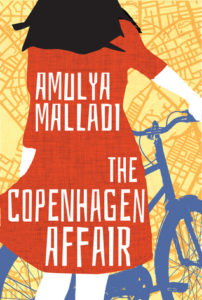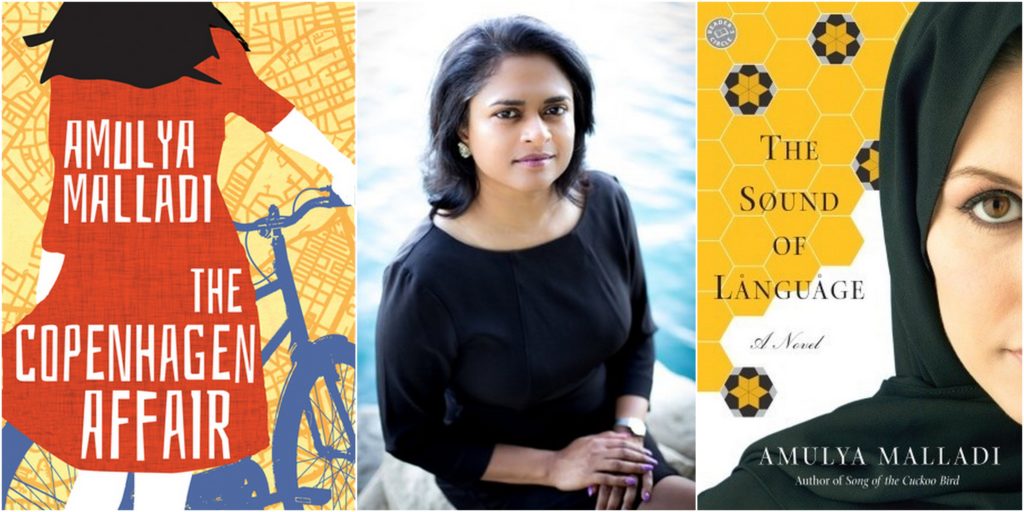I was thrilled to come across a new-to-me author with contributions to the world of Scandinavian-themed literature. Amulya Malladi from India is the author of seven novels, most of which revolve around Indians in America or back in India. However, two of her novels take place in Denmark and explore Danish culture with a keen eye.
I first came across Malladi when I saw her latest novel, The Copenhagen Affair, offered at NetGalley this past fall. I was immediately drawn to the cover with a lady and a bicycle in Copenhagen. After some quick research, I learned Malladi has a Danish husband and lived in Denmark for fourteen years before moving to southern California. I was relieved to know that she was writing about a time and place that she had experienced personally and knew well. Her other book set in Denmark is The Sound of Language.
For readers pursuing my 2018 Scandinavian Reading Challenge, Malladi’s books set in Denmark fulfill various categories—a book set somewhere in Scandinavia you would like to visit (or revisit), a Scandinavian book published in the last year (The Copenhagen Affair), an immigrant story (The Sound of Language), and potentially, a Scandinavian or Scandinavia-themed book whose cover piqued your interest.
 Malladi’s novel The Sound of Language (published in 2007) went to the top of my TBR list when I learned it was an immigrant story set in Denmark. It was the first book of hers that I read. The story takes place in 2002 in the small town of Skive on the Jutland peninsula. It’s about Raihana, a woman from Afghanistan who immigrates to Denmark after her husband was captured by the Taliban. Raihana is an openminded and forward-thinking immigrant eager to integrate into Danish society. However, neither the Danish people nor her immigrant community is always welcoming or supportive. The book delves into how she becomes accustomed to this very different place and new culture. It was an interesting and touching look at the immigrant debate in Denmark.
Malladi’s novel The Sound of Language (published in 2007) went to the top of my TBR list when I learned it was an immigrant story set in Denmark. It was the first book of hers that I read. The story takes place in 2002 in the small town of Skive on the Jutland peninsula. It’s about Raihana, a woman from Afghanistan who immigrates to Denmark after her husband was captured by the Taliban. Raihana is an openminded and forward-thinking immigrant eager to integrate into Danish society. However, neither the Danish people nor her immigrant community is always welcoming or supportive. The book delves into how she becomes accustomed to this very different place and new culture. It was an interesting and touching look at the immigrant debate in Denmark.
An unexpected delight of the book was how beekeeping was integrated into the story. Raihana had some experience with bees from her earlier life in Afghanistan so her Danish language teacher coordinated an apprenticeship with a Danish man who used to keep bees with his recently deceased wife. Interspersed with the current progress of Raihana and Gunnar’s beekeeping are excerpts from Gunnar’s late wife’s beekeeping diary. Gunnar’s wife comes alive through these diary entries and is a welcomed character in the story.
One of my favorite aspects of the book was how Gunnar and Raihana helped each other and how they helped the people in their own communities open their minds to people unlike themselves. I admired both of them for persevering with this unlikely friendship despite pushback from their respective communities. I really enjoyed the book and highly recommend it.
 The Copenhagen Affair (published in 2017) is Malladi’s second book to feature Denmark, and it’s totally different than the first one. Malladi herself describes this book as a “comedy about depression” and a “love letter to Copenhagen.”
The Copenhagen Affair (published in 2017) is Malladi’s second book to feature Denmark, and it’s totally different than the first one. Malladi herself describes this book as a “comedy about depression” and a “love letter to Copenhagen.”
The book delves into the misconception that “emotional baggage will disappear if one changes geographies.” It’s about an American couple who decides that a move to Copenhagen, Denmark, is the right next step for them after the wife Sanya has had a nervous breakdown at her workplace and now suffers from depression. Her husband Harry has a work opportunity there, and according to him, the temporary move would improve his wife’s health.
While Harry spends his days at work, Sanya spends hers at home under her duvet. Slowly, she comes out of her shell and begins to interact with people in the city and get used to her new self. She meets and becomes attracted to a man whom it turns out owns the company that Harry’s company is acquiring. Sanya struggles with the conflict of previously being “Old Sanya” (happy and positive, devoted to work and family, eager to please) and now becoming “New Sanya” (depressed, at times difficult and stubborn, attracted to defects and the unknown). As the story progresses, Harry and Sanya are also forced to contemplate their marriage and the future of it.
Though I felt some sympathy for Sanya and her struggles with depression and anxiety, I did not care for most of the supporting characters in the story. They were all generally part of Copenhagen’s wealthy, elite class. The women were only interested in designer brand names and gossip. They were actually a bit representative of “mean girls.” Even Sanya at one point described one of the women as being a “vindictive little bitch.” And in this society, hitting on others’ spouses and having affairs was commonplace. Not my ideal kind of people to hang out with.
I did enjoy the book more when Sanya, a financial consultant by trade, began to take an interest in her husband’s business acquisition deal and put her skills to use to try to find out what was actually going on. It became a little bit of a financial mystery story then which made the book more interesting to me. The ending, though a little over the top, made me hopeful that Sanya and Harry would work things out one way or another.
Overall, it was an enjoyable book. It was a quick and easy read. One aspect I especially enjoyed was the setting. Malladi certainly showed she knows Copenhagen well. She often mentioned specific stores, cafes, restaurants, and parts of town. For anyone wanting to visit or revisit Copenhagen, this book certainly provides that opportunity.
Both books have bold, captivating covers, but be aware they are misleading. The cover of The Sound of Language shows a woman wearing a hijab. The main character Riahana, however, does not wear one and the decision to do so is a point of discussion several times in the novel. Also, much to my chagrin, the cover incorporates the Scandinavian letters “å” and “ø” into the title so the title is actually shown as “The Søund of Långuåge.” I shudder just looking at it; the sounds the letters make don’t work with the words at all. If they had, that could have been a clever marketing ploy.
The cover of The Copenhagen Affair shows a very pale woman with a bicycle. First of all, the main character Sanya is ethnically Indian. Her darker skin comes up a couple of times in the book. Also, Sanya does not ride a bike nor does she express any interest in bicycles. There is the one time when she went off one evening with a new friend and she sat in the front carriage of a bicycle. Other than that, bicycles are just used to describe life in the city. I was expecting a bicycle to play a role in the main character’s life in Copenhagen.
I would have loved to hear the discussions behind the decisions of going with these cover designs and what Malladi’s opinions on them were. But don’t let the misleading covers stop you from reading these books. They are wonderful additions to the world of contemporary Scandinavian literature.


